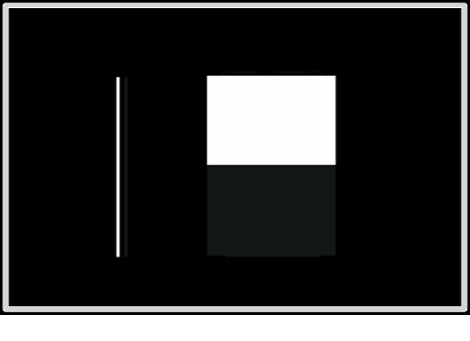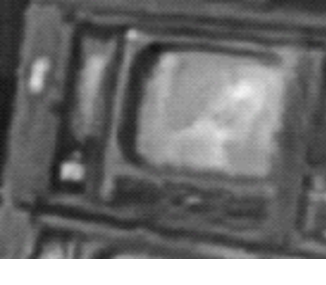Alec Bray
The PLUGE that I remember – to set up the monitors for Vision Control – was more like this:
You had to set the black level using the bars on the left (the black bar just visible)and then get a photography light meter and tweak the contrast so the white area gave a certain reading (hopefully this reading was reached before the white area defocused).
Does anyone have better information?
Dave Plowman
That’s the Picture Line Up Generator Equipment I remember. In theory had a super black bar you didn’t see? But racks seemed to set their monitors so it was visible, so a bit of lift?Ian Hillson
Yes, they were set ever-so-slightly wrong, but consistently so! The trouble was, monitors used to drift, just like the rest of the kit, so best not to line-up immediately after they were turned on. Think I’m right in saying that’s why colour camera tube heaters were left on in the tech store overnight.The trouble with setting the darkest PLUGE bar so that it wasn’t discernible was that if the monitor brightness drifted down, you’d only notice this when the remaining bar disappeared. Newbies tended to think that everything needed lining up as soon as you got in, in a morning, instilled at Wood Norton. Some took a bit of persuading to leave for a bit for the old tech to warm up and drift in. The equipment that is, not the occupants of the chairs.
Geoff Fletcher
Writing here as an ex BBC TV camera guy who never wanted to get over involved in the tech side of things, wasn’t there a device the VMs and/or Vision Engineers used which attached to the monitor face to ensure PLUGE was tweaked properly? Or am I confusing this with something used when lining up colour monitors later on?Chris Woolf
That was the light meter – some had a suction cup to hold it on to the screen. You were supposed to put a meter on the white to preset a constant output across all monitors in a bank,Alec Bray
If I recall correctly, in Vision Control (based on a short assignment to VC – my claim to fame is that I was the Vision Control operator on the last episode of "Compact" (a soap opera done LIVE from TC2 !!), you did not use the monitor bank to check on picture match and picture quality. The top left monitor in the bank was the TX monitor, the top RIGHT was a preview monitor, selected by pressing down on the camera iris/black level control. Each camera should look the same when selected on the preview monitor.The other "aid" was an oscilloscope mounted vertically next to each camera’s monitor (and TX and preview). This showed a complete field – the top of the field was on the left and the bottom on the right, so the "picture" was at right-angles to the monitor picture, but the width (that is, the field height) was compressed – something like this:

(BTW I have found it hard to get any decent pictures of the Vision Control position in Television Centre studios!)
The monitor showed black level (on its pedestal) and peak whites. The overall balance of the picture could be gauged by the pattern shown up by the oscilloscope. So on transmission, you set the picture from a camera as best as possible using a combination of the oscilloscope and the monitor, then switched that camera onto the preview monitor to check its match to the other cameras.
This you had to do constantly, because of variations in the lighting conditions for each camera shot (however good the TM1 (in those days) or bad … and because of the drift by camera tube and monitor settings since line-up.
One program in TVT – famous American singer – camera (Pye Mk 5 with Angenieux Zoom) on a pedestal on stage left (off-prompt) – on transmission the iris only responded to CLOSE. So once I stopped down the iris there was no way back! Frantic juggling with gamma and black level to try to keep the singer’s face from plunging into the gloom. Turned out that the zoom was misaligned on the iris drive splines: rectified in a recording break I seem to recall.
Mind you, I only did VC in Television Centre and TVT. Other studios may have differed …
Chris Woolf
You did need to make sure the PV and TX monitors (always the higher grade ones) were as good a match as possible, or otherwise you would get a nasty shock when the source was punched to TX. But the lower banks needed to be tolerably matched too since VCs usually tried to keep all cameras exposed roughly correctly at all times – partly to avoid sudden surprise cuts, and also to help the cameraman.I never did VC at the Centre, though I did a lot of inlay/overlay work which entailed camera line up and control. But I did do some VC for ITV, and the control arrangements were pretty well identical. The BBC really was the industry leader those days, and everyone else realised the sense, and followed. The in-view vertical waveform monitor didn’t travel everywhere, and you more often saw a desk-mounted Waveform Monitor that followed the PV, but you tended to do the matching largely by eye – just as sound mixers use their ears with only an occasional reference to the PPM.
The lighting guy was important, but no matter how good the exposure, couldn’t be left entirely to him (though they usually wanted the knobs left centred during early rehearsals to allow them to get things right). But shot-to-shot balance did depend on shot content to some extent – an over-the-shoulder, with a lot of dark suit in shot, didn’t look right if it gave a massive overall brightness change on a cut, so needed a degree of riding, while keeping face tones roughly constant.
Alec Bray
[An Engineering Department reprint of “Testing and Operation of 4 ½ in Image Orthicon Tubes”] is all about setting up, testing, and engineering operation of the 4.5 in Image Orthicon – and dates from 1959.Here’s a quote from the document:
"… In the writer’s opinion this situation is best met in the following way: The operator is provided with a light input control (preferably remote iris), a very fine "lift" control (for trimming out glare, flare and similar effects) and a selector switch at each position of which is a preset combination of lift, gain and black stretch, carefully set for optimum signal/noise ratio for the particular contrast law required…."
Which is pretty much what was put in place at Television Centre – except that the selector switch was replaced by a gamma control which (if I recall correctly) was continuously variable and not stepped.
Chris Woolf
In the bad old days it was normal to set a so-called pedestal – a slight lift of ~2% (I think) across the picture. Thus the black background – nominal black – was at pedestal level, whereas the first vertical bar was 0% – marginally blacker.By dropping the brightness down till the first bar just disappeared you knew that the (pedestal) background wasn’t being crushed – the second bar was 2% brighter than pedestal, and so should have been just visible.
And yes, you were supposed to put a meter on the white to preset a constant output across all monitors in a bank, and to check the grey bar to prove that the tube gamma was ~about~ right. In practice you were lucky if the output and gamma were anywhere near the prescribed value, once the tubes had seen a few months of near-continuous service.



